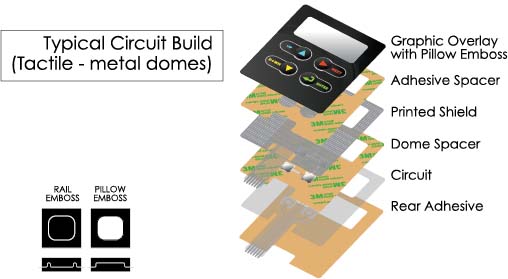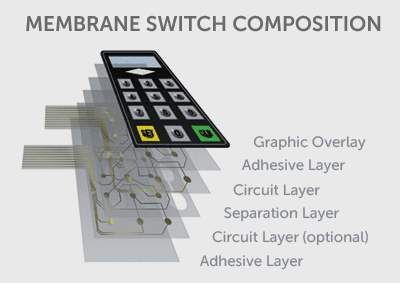The Role of Membrane Switch Technology in Improving Product Interfaces
The Role of Membrane Switch Technology in Improving Product Interfaces
Blog Article
Recognizing Membrane Layer Switches: The Key to Trustworthy and durable Controls
Membrane layer switches stand for an important aspect of modern user interface layout, mixing performance with strength in different applications. As we discover the complexities of membrane switches, it ends up being clear that their duty in boosting control systems is both complicated and extensive, increasing questions concerning just how best to utilize their abilities in future developments.
What Are Membrane Switches?
Membrane layer buttons are a sophisticated solution in the realm of interface modern technology, integrating performance and style perfectly. These gadgets act as a user interface between customers and electronic systems, integrating numerous elements right into a small style. Commonly created from adaptable, thin layers of products, membrane layer switches are made to react to touch, enabling customers to engage with equipment and electronic tools properly.
The primary elements of a membrane layer button consist of a published circuit layer, graphic overlay, and a spacer layer that stops unintended activation. The visuals overlay can be customized to reflect brand identity or customer preferences, improving looks while guaranteeing use. Membrane buttons are typically used in numerous applications, including clinical tools, customer electronic devices, and commercial devices, owing to their toughness and resistance to environmental factors such as dampness and dust.
One of the essential advantages of membrane layer switches is their capacity to hold up against wear and tear, making them ideal for high-traffic environments. Additionally, they are lightweight and call for very little area, permitting cutting-edge layouts in product advancement. Generally, membrane switches over stand for a functional and effective selection for modern-day digital interfaces, weding innovation with user-centric layout concepts.

Exactly How Membrane Layer Switches Work
The procedure of membrane layer switches over hinges on an easy yet reliable system that converts customer input into digital signals. These buttons contain multiple layers, commonly consisting of a visuals overlay, a spacer layer, and a circuit layer. When a customer presses the button, the leading layer warps, enabling a conductive element in the circuit layer to make call with an equivalent conductive pad on the bottom of the visuals overlay. This call closes the circuit and sends out a digital signal to the gadget, showing that the button has been triggered.
The layout of membrane switches can differ, however they typically incorporate domes or responsive elements to give responses to the user, improving the total experience. The products utilized in membrane switches, such as polyester or polycarbonate, add to their longevity and resistance to ecological aspects, including wetness and dirt. Furthermore, the published circuits are normally enveloped, which protects them from damage with time.

Advantages of Membrane Buttons
One of the key benefits of membrane buttons visit their website is their convenience in layout, permitting them to be tailored to fulfill certain customer demands and aesthetic needs. This flexibility includes numerous industries, where get more various forms, dimensions, and colors can be utilized to enhance user communication and visual allure.
Additionally, membrane layer buttons are recognized for their longevity. Built from durable materials, they are resistant to dirt, dampness, and physical wear, which significantly extends their life expectancy contrasted to conventional mechanical buttons. This longevity makes them especially appropriate for high-traffic settings and applications requiring longevity.

Furthermore, membrane layer buttons offer a structured profile, causing a thinner design that can be incorporated into various gadgets without adding mass. This attribute not only improves the visual appeal however additionally adds to a more ergonomic product design.

Applications of Membrane Buttons
Straightforward and flexible, membrane buttons discover applications across a large range of markets, including medical devices, consumer electronic devices, and industrial tools. In the clinical area, these switches are integral to tools such as analysis equipment, client surveillance systems, and mixture pumps, where dependability and ease of cleaning are important. Their ability to maintain and endure extreme atmospheres capability makes them excellent for such applications.
In consumer electronic devices, membrane buttons are made use of in items like microwaves, washing equipments, and push-button controls - membrane switch. Their smooth layout enables user-friendly interface, improving the overall individual experience while supplying toughness and resistance to deterioration
Industrial equipment likewise gains from membrane buttons, especially in control panels for machinery and automation systems. These switches use security against dirt and moisture, ensuring consistent performance in tough environments. Furthermore, their personalized functions allow producers to tailor them to particular operational requirements, boosting efficiency and capability.
Choosing the Right Membrane Layer Switch Over
When selecting a membrane switch, it is vital to think about different variables that influence performance and important site viability for specific applications. The key considerations consist of ecological conditions, responsive responses, sturdiness, and style specifications.
First, evaluate the operating atmosphere; buttons subjected to moisture, chemicals, or extreme temperatures call for certain products to make sure longevity and capability. Next off, examine the demand for responsive responses. Depending on customer interaction, some applications may take advantage of a tactile feedback to confirm activation, while others might prefer a non-tactile layout for visual factors.
Sturdiness is an additional essential variable; membrane switches need to be developed to stand up to regular use, impacts, and abrasion. Make sure the chosen button can endure the anticipated lifecycle, particularly in high-usage scenarios.
Verdict
In conclusion, membrane layer switches over serve as crucial elements in the design of trusted and long lasting control systems throughout various markets. The adaptability of membrane switches enables for customized remedies that fulfill certain operational needs, enhancing their importance in modern-day innovation.
Membrane switches represent a critical facet of contemporary interface design, mixing capability with resilience in various applications.Membrane layer buttons are an advanced remedy in the realm of customer interface innovation, integrating performance and style seamlessly. Generally built from flexible, thin layers of materials, membrane buttons are designed to respond to touch, allowing customers to communicate with equipment and digital devices properly.
The layout of membrane layer switches can differ, yet they usually incorporate domes or tactile components to supply responses to the user, improving the overall experience.In conclusion, membrane layer switches offer as crucial components in the layout of durable and reliable control systems throughout numerous markets.
Report this page